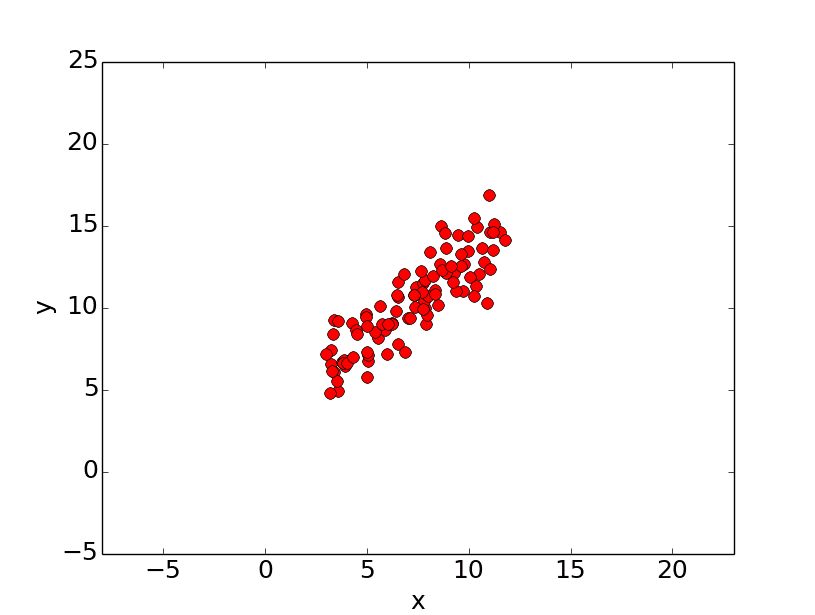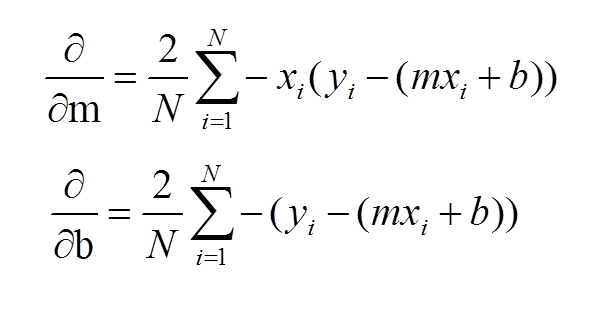1
2
3
4
5
6
7
8
9
10
11
12
13
14
15
16
17
18
19
20
21
22
23
24
25
26
27
28
29
30
31
32
33
34
35
36
37
38
39
40
41
42
43
44
45
46
47
48
49
50
51
52
53
54
55
56
57
58
59
60
61
62
63
64
65
66
67
68
69
70
71
72
73
74
75
76
77
78
79
80
81
82
83
84
85
86
87
88
89
90
91
92
93
94
95
96
97
98
|
from numpy import *
import numpy as np
def compute_error_for_line_given_points(b, m, points):
totalError = 0
for i in range(0, len(points)):
x = points[i, 0]
y = points[i, 1]
totalError += (y - (m * x + b)) ** 2
return totalError / float(len(points))
def update_mini_batch(b, m, mini_batch, learningRate):
N = float(len(points))
b_gradient,m_gradient = compute_cost_gradient_of_all(mini_batch,b,m)
new_b = b - (learningRate/N) * b_gradient
new_m = m - (learningRate/N) * m_gradient
return [new_b, new_m]
def compute_cost_gradient_of_all(points,b,m):
b_gradient = 0
m_gradient = 0
for i in range(0, len(points)):
delta_b,delta_m = compute_cost_gradient_of_one(points[i],b,m)
b_gradient += delta_b
m_gradient += delta_m
return [b_gradient,m_gradient]
def compute_cost_gradient_of_one(point,b,m):
x = point[0]
y = point[1]
b_gradient = -2 * (y - ((m * x) + b))
m_gradient = -2 * x * (y - ((m * x) + b))
return [b_gradient,m_gradient]
def gradient_descent_runner(points, starting_b, starting_m, learning_rate, epoches):
b = starting_b
m = starting_m
for i in range(epoches):
b, m = update_mini_batch(b, m, array(points), learning_rate)
return [b, m]
def gradient_descent_runner_with_mini_batch(points, starting_b, starting_m, learning_rate, epoches,mini_batch_size):
b = starting_b
m = starting_m
n = len(points)
num_batches = n/mini_batch_size
for i in range(epoches):
np.random.shuffle(points)
for k in xrange(0,num_batches):
mini_batch = points[k*mini_batch_size : (k+1)*mini_batch_size]
b, m = update_mini_batch(b, m, mini_batch, learning_rate)
return [b, m]
def run():
points = genfromtxt("data.csv", delimiter=",")
learning_rate = 0.0001
initial_b = 0
initial_m = 0
epoches = 1000
print "Starting gradient descent at b = {0}, m = {1}, error = {2}".format(initial_b, initial_m, compute_error_for_line_given_points(initial_b, initial_m, points))
print "Running..."
[b, m] = gradient_descent_runner(points, initial_b, initial_m, learning_rate, epoches)
print "After {0} iterations b = {1}, m = {2}, error = {3}".format(epoches, b, m, compute_error_for_line_given_points(b, m, points))
def run2():
points = genfromtxt("data.csv", delimiter=",")
learning_rate = 0.0001
initial_b = 0
initial_m = 0
epoches = 1000
mini_batch_size = 10
print "Starting gradient descent at b = {0}, m = {1}, error = {2}".format(initial_b, initial_m, compute_error_for_line_given_points(initial_b, initial_m, points))
print "Running..."
[b, m] = gradient_descent_runner_with_mini_batch(points, initial_b, initial_m, learning_rate, epoches,mini_batch_size)
print "After {0} iterations b = {1}, m = {2}, error = {3}".format(epoches, b, m, compute_error_for_line_given_points(b, m, points))
if __name__ == '__main__':
run()
|







